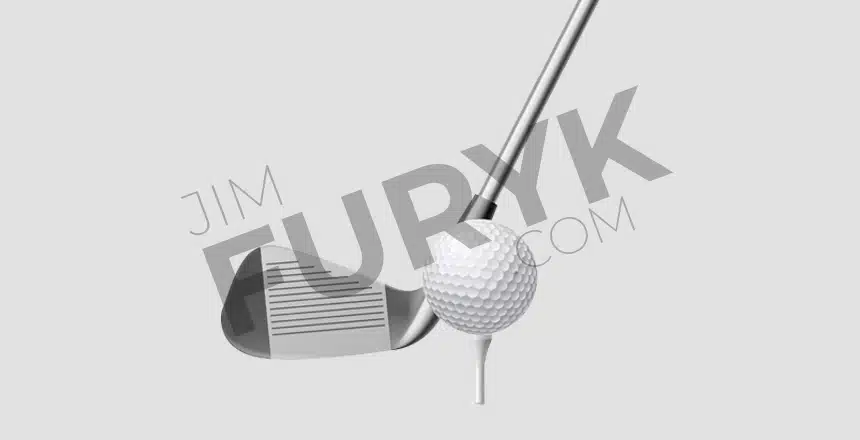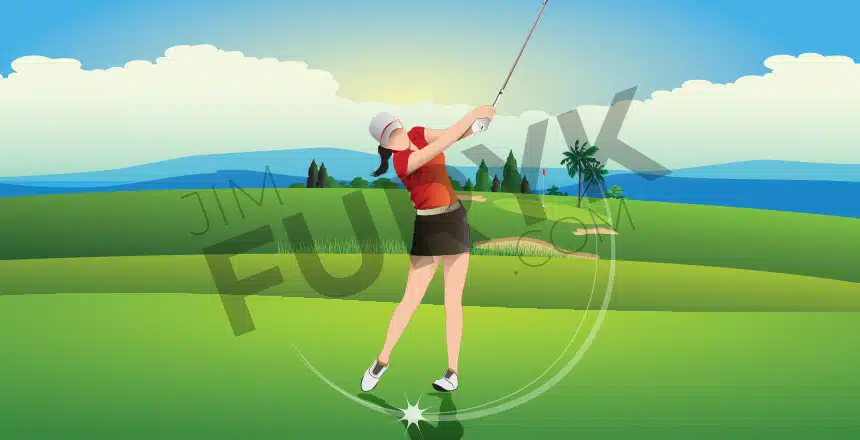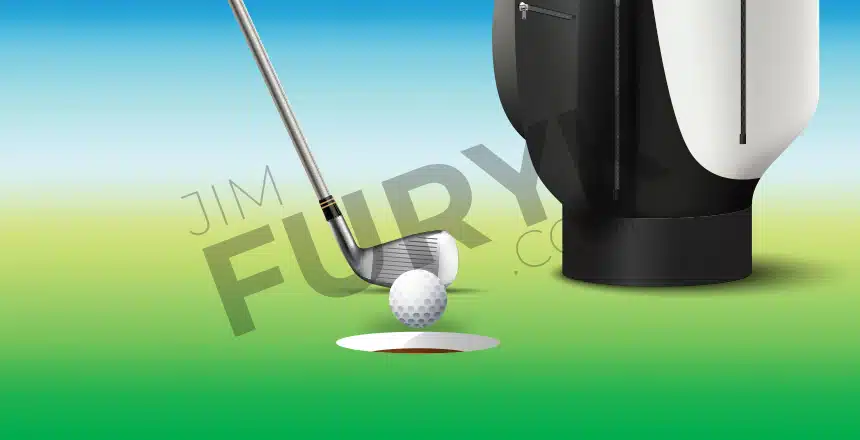The 8-iron in golf is one of the most dependable clubs, especially when you’re thinking about upgrading your greenside performance. It is a highly versatile golf club that many players use for a variety of shots and from a variety of positions. To put it simply, the 8-iron is perfect for improving your golfing skills.
No matter how tricky or difficult the situation, 8-iron has the ability to produce great shots. All thanks to the high flight angle it can create even in the case of challenging shots that demand maximum accuracy and control from your side.
What’s also quite remarkable about the 8-iron is that it’s a good choice for beginners as well since it’s so easy to play.
So, in this post, the points that will be discussed include the length, loft, distance, and playability of 8-iron. Time to tee off and get to know all about the dexterous golf club that is the 8-iron!
In This Post
8-Iron in Golf – Everything You Need to Know About It
What Is An 8-Iron?

The 8-iron, also known as a short iron, can be most accurately described as a golf club that can be utilized for a wide range of shots to improve gameplay. It generates a higher loft but yields mid-range to short distances.
Needless to say, 8-irons are numbered golf clubs made using iron material, unlike their wooden and non-numbered counterparts. Since the club has an iron construction, it’s heavier and that’s why it has such a direct and calculating impact on distance. Wooden golf clubs are for teeing off whereas iron clubs you use after the first tee shot.
So what does the number 8 mean? It means that the 8-iron is a higher-end golf club capable of improving performance by cloaking mistakes.
The loft angle is the angle at which you can control your shot (more on golf club loft angle). In turn, this affects not just distance but also trajectory. The rule of thumb here is that the higher the number of the club, the better the trajectory of your shots. Therefore, higher golf club numbers improve gameplay.
8-Iron Distance
Driving distances in golf are considered to be very important, and there’s good reason for that – they can either make or break your entire round of golf. But you cannot also undermine the type of golf club you use, along with your swing technique of course.
When you choose lower-numbered clubs, you can hit longer distances with a lower trajectory. As for the 8-iron, it’s a versatile golf club that, on average, produces a distance of 130 yards.
And since it’s a higher-numbered club, the trajectory is higher too. It’s also perfect for generating moderate to short distances as well as for chipping (till the middle pin).
Weather conditions also play a huge role here. Meaning if the weather is bad or unfavorable, then improvement may not be a part of your game. Likewise, your age and strength also matter.
- Between 20 and 30 years old: 150 yards distance
- Between 30 and 40 years old: 145 yards distance
- Between 40 and 50 years old: 137 yards distance
- Between 50 and 60 years old: 130 yards distance
- 60 years old and above: 120 yards
8-Iron Loft
Do you really need to hit or launch your shots very high, as the pros do? Yes or no, either way, you need to understand that shooting the golf ball high doesn’t just require a powerful swing. The loft angle of your club, at such times, is significant too. Now you probably know why not all golf irons have the same loft degree.
Typically, the 8-iron has a loft angle between 37 and 39 degrees. Depending on the brand, this particular golf iron can also be equipped with game improvement technology to enhance performance even for high-handicap players. A good example would be these best mid-handicap irons tailored to improve distance, feel, and control.
8-Iron Length
What is the standard 8-iron length?
For a comfortable grip, you should be using the right golf club shaft length.
Not many golfers know that swing weight also determines club length. The swing weight of one player differs from that of another. And every swing weight demands its proper size in order to be upheld adequately. This also ensures that each golf club’s head weight is well-balanced.
Now you may already know that not all irons have the same shaft length. Once again, swing weight differs and so does the wrist-to-floor measurement. So it’s crucial to find a fit that is perfect for you.
As for the 8-iron, the standard length is between 35.5 and 37 inches.
8-Iron Swing Speed Chart
| Swing Speed | 8-Iron Distance |
|---|---|
| Slow swing speed (<70 mph) | Under 140 yards |
| Average swing speed (70–85 mph) | Around 140–160 yards |
| High swing speed (>85 mph) | More than 160 yards |
8-Iron Distance Based on Golf Handicap
Straight to the point – handicap has nothing to do with distance. Does this mean higher handicappers can hit their shots as long as lower handicappers? The answer lies in the fact that the distance you acquire with your golf irons is more affected by your swing speed than any other factor.
Also, shooting farther doesn’t necessarily lower your scores because many players have scored low without generating a distance of more than 135–140 yards.
Most Effective Tips for Hitting An 8-Iron the Right Way!

1. Creating Solid Contact
Here’s an extremely helpful video that teaches you how to take a divot with your irons in a matter of just a few minutes.
The best contact is made through a good divot, irrespective of whether it’s with your 8-iron or 5-iron or sand wedge. The point of contact between the iron and turf is very important, especially if your motive is to establish a more consistent distance. So focus more on practicing taking divots and less on hitting fat shots.
2. Knowing the Shape of Your Shots
The shape here refers to the golf ball flight, which is something you absolutely need to know yet most golfers overlook. Play a few practice rounds to check how many times you hit a draw (right to left) or a fade (left to right). And then once you figure it out and know your natural shot-shaping tendencies, you can use those to your advantage.
For instance, PGA Tour players prefer hitting a fade as it generates a consistent, reliable shot shape. Fades are easier to control and create more spin – the latter equals greater stopping power on the green. Also, a fade, more often than not, doesn’t turn into an unwanted slice or hook.
3. Aiming Toward Your Target Line
The clubface should do the following…
- It has to face in the direction of an actual thing like a leaf or divot on the ground, in front of the golf ball (at a distance between 1 and 3 feet from the ball).
- It must aim toward the target but don’t forget to take your shot shape into consideration so the ball can curve toward your target.
- Make sure to choose a high target beyond the green or pin, such as a branch of a tree.
- Just before the 8-iron comes in contact with the golf ball, glance at the target spot and you’ll notice the difference (or rather improvement) in your shot.
4. Knowing Your Carry Distance
The average carry distance of a PGA Tour golfer with the 8-iron is between 160 and 180 yards. So if you’re a beginner or amateur player and also a high handicapper, don’t harbor any delusions of achieving those distances just like that.
What matters more here is that you know your maximum distance potential to become a better golfer.
Here’s an article on Average Golf Club Distances if you want to know how far you ought to be hitting your irons, woods, and wedges.
5. Trusting the Loft of the 8-Iron
If you want the golf ball to get airborne easily and high enough using short irons, do you really have to get under the ball or add loft? Nope, neither is a necessity. Instead, what works is de-lofting your iron through impact to create the required backspin that, in turn, produces the much-needed lift.
Hence, with a short iron like the 8-iron, you have to trust its loft degree. Golf club manufacturers take into account crucial factors like flight dynamics.
Do not try to lift the golf ball at impact, rather place 60% of your body weight on the front foot and hit down on that ball. This will yield spin and speed and also compress the golf ball so it flies better.
6. Hitting Chips with the 8-Iron
Ditch your go-to wedge for the 8-iron for practicing chip shots.
- With the help of smaller golf swings, focus more on making “sweet spot” contact and establishing clubface control while also getting a better feel of impact.
- Try chipping your shots around 11–12 yards away from where you’re standing – at a distance of about 2 yards off the green.
- Your aim should be to get the golf ball to land on a particular spot. Ensure that you’re playing off the back foot, so you don’t actually need to assist the ball to become airborne. And simply imagine you’re playing the pitching wedge.
7. Using Forgiving Irons
If your goal is to hit better iron shots, you really must choose the most forgiving irons. These are built with a larger clubhead, lower CG, and perimeter weighting. All of which contribute greatly to turning your mis-hits into straighter, longer shots.
Here’s one of the best instructional videos you can watch before and after your every round of golf just to learn how to hit the 8-iron as far as possible.
Frequently Asked Questions (FAQs) About 8-Iron
Is the 8-Iron Easy to Hit?
Because of the higher loft and shorter shaft, an 8-iron is one of the easier golf clubs to play. Since the loft angle is higher and the shaft length shorter, you can really maximize trajectory and control.
When to Use the 8-Iron?
Remember that this is a highly versatile golf club, so it can be used in various scenarios for various shots. Although the 8-iron is most commonly used to hit approach shots, pitches, chip shots, and short-distance tee shots.
How Far Does Tiger Woods Hit the 8-Iron?
Tiger Woods is ruthless with golf irons! Here are the yardages achieved by him with his irons:
- 8-Iron: 195 yards
- 7-Iron: 180 yards
- 5-Iron: 250 yards
- 4-Iron: 255 yards
- 3-Iron: 240 yards
How to Hit 150 Yards with the 8-Iron?
It largely depends on multiple factors – your age, posture, strength, and technique. Naturally, beginners will generate shorter distances in comparison to more experienced golfers. Likewise, younger players hit farther down than golfing veterans.
But this doesn’t mean you can’t learn how to hit longer. With the right tips, you will be able to unlock greater distance potential with your 8-iron. One very effective way is by improving swing speed.
Here are five others to get an 8-iron to achieve a distance of 150 yards:
- 1. Take into consideration and gauge elevation changes of the place where the golf ball is going to land.
- 2. Also check the surroundings of the lie – if the ball remains on the fairway, then you’re most likely to produce 150 yards.
- 3. To know how strong your golf swing needs to be, you have to measure three distances. One, distance to the front of the green. Two, distance to the back of the green. And three, distance to the flag.
- 4. Take into account the weather conditions. Warmer weather means better pace as well as longer distances. On the other hand, cold weather creates the opposite effect.
- 5. Do you swing a little too excessively to the left? If yes, you should work toward changing those movements. Otherwise, the ball will not generate the desired yardage.
What Is the Difference Between 5-Iron and 8-Iron?
The main difference between the two – loft angle and distance.
| Golf Iron | Loft Angle | Distance |
|---|---|---|
| 5-Iron | Lower | Between 170 and 190 yards |
| 8-Iron | Higher | Between 120 and 150 yards |
What Is the Difference Between 8-Iron and 9-Iron?
Once again, the main difference takes the form of loft angle and distance produced.
The 9-iron is primarily used for shorter shots (when and how to use a 9-iron). Here the loft is higher than that of 8-iron but it typically achieves a distance of 110–140 yards. While the lower-lofted 8-iron usually makes the golf ball travel anywhere between 120 and 150 yards.
Conclusion
When on the golf course and you need to hit a specific shot, you now know that you can rely on the 8-iron. It will get the job done the most easily and accurately! Thanks to its forgiving and versatile construction. You get amazing control as well.
The 37–39 degree of loft angle procures the most advantageous combination of high trajectory and moderate distance.

